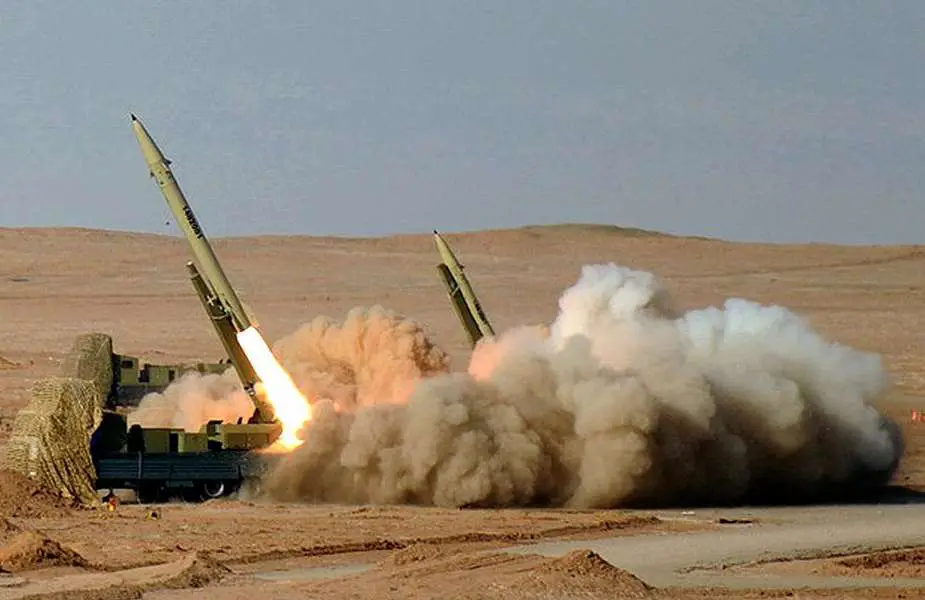- Army
- Conflicts in the world
- Israel - Iran conflict 2025
- Pakistan - India Conflict 2025
- Russia Ukraine War 2022
- Libya conflict day by day
- HAMAS - Israel War 2023
- Operation Serval in Mali French Army
- Sangaris operation Central African Republic
- Sangaris opération militaire République Centreafrique
- Ukraine - Russia conflict
- Syria conflict news
- Defence & Security Industry Technology
- Armies in the world
- Analysis Defense and Security Industry
- Conflicts in the world
- Navy
- Air
Russia Eyes Iranian Fateh-110 Ballistic Missiles for Heavy Usage in Ukraine War
Following a visit of the Russian defense minister to Iran on September 21, 2023, Russia showed interest in purchasing an Iranian-made Fateh-110 short-range ballistic missile to compensate for the heavy use of missiles in the conflict in Ukraine, and manufacturing delays in the Russian defense industry.
Follow Army Recognition on Google News at this link

Islamic Revolutionary Guard Corps IRGC aerospace chief Hajizadeh showed Russian Defense Minister Shoigu an Iranian-made missile. (Picture source Russian MoD)
According to information released by the Washington-based Institute for the Study of War, Russia could conclude an agreement with Iran for the acquisition of Fateh-110 ballistic missiles after a visit of a Russian Ministry of Defense delegation to Iran. Russia and Iran share a multifaceted defense technology relationship, marked by arms sales, nuclear cooperation, and shared regional interests, especially in Syria. Historically, Russia has supplied Iran with military equipment, including the notable S-300 air defense system. Russia has also assisted Iran in its civilian nuclear energy program, exemplified by the Bushehr nuclear power plant.
Both nations, facing international sanctions, have found common ground in opposing Western dominance in regional affairs. However, underlying distrust exists due to Russia's ties with Israel and historical competition in the Caucasus and Central Asia. While defense technology is a key aspect of their ties, they also collaborate in areas like energy, trade, and infrastructure. Future cooperation will depend on geopolitical shifts, international stances, and domestic politics.
Kyiv has claimed that Russia utilized Iranian-made weapons in the conflict in Ukraine. Ukrainian President, Volodymyr Zelenskyy, directed the Foreign Ministry to address the evidence of the use of Iranian-produced weapons by Russian troops. This claim was based on intelligence data and media reports that were later confirmed on the battlefield. Sergii Nykyforov, the presidential spokesman, mentioned that these actions by Iran go against the sovereignty and territorial integrity of Ukraine and endanger the lives of Ukrainian citizens. Despite these allegations, Iran's public leadership has repeatedly expressed its neutrality and offered to mediate in ending the war.
The Ukrainian government has reported that Russian forces used Iranian kamikaze drones in their attacks on Ukrainian cities. Specifically, the drones identified were the Shahed-131 and Shahed-136 models. The report indicates that over 600 drone attacks on Ukrainian cities occurred in the span of three months. The document also suggests that there was potential cooperation between Russia and Iran in drone production, with the Shahed-136/131 UAVs being transported from Iran to Russia across the Caspian Sea. The report further highlighted that Russian forces might have started referring to these drones as Geranium-1 and Geranium-2, possibly to conceal Iran’s involvement.

The Fateh-110 is an Iranian-made solid-fueled surface-to-surface ballistic missile produced by Iran's Aerospace Industries Organization since 2002. (Picture source Wikimedia)
The Fateh-110 is an Iranian short-range, road-mobile, solid-fueled ballistic missile. Developed by Iran's Aerospace Industries Organization, the missile is an integral part of Iran's strategic missile force and is designed for precision strikes against both ground-based and naval targets.
One of the primary technical features of the Fateh-110 is its solid propulsion system, which offers advantages in terms of rapid launch readiness and reduced logistical needs compared to liquid-fueled missiles. The missile has a range of approximately 300 kilometers, allowing it to cover significant portions of the Middle East when launched from Iranian territory.
The missile is equipped with an inertial navigation system, which, when combined with its guidance system, allows for high accuracy in hitting targets. In later versions, improvements in guidance systems have been reported, with some sources suggesting the integration of a GPS system to further enhance its precision.
In terms of combat capabilities, the Fateh-110 is designed to deliver a conventional warhead, although there have been speculations about potential chemical, biological, or even nuclear warhead capabilities. Its high accuracy makes it particularly effective against high-value targets, including command and control centers, airbases, and critical infrastructure. Additionally, its ability to be rapidly deployed and launched makes it a formidable asset in terms of tactical flexibility and as a deterrent against potential adversaries.
Furthermore, the Fateh-110 has seen several upgraded variants since its initial introduction, with enhancements in range, accuracy, and payload capacity. The missile's adaptability and continuous improvements underscore Iran's commitment to maintaining a credible ballistic missile capability as a core component of its defense strategy.
News Russia Ukraine War


























